The seasonal dynamics and biting behavior of potential Anopheles vectors of Plasmodium knowlesi in Palawan, Philippines
- PMID: 34233742
- PMCID: PMC8261946
- DOI: 10.1186/s13071-021-04853-9
The seasonal dynamics and biting behavior of potential Anopheles vectors of Plasmodium knowlesi in Palawan, Philippines
Abstract
Background: A small number of human cases of the zoonotic malaria Plasmodium knowlesi have been reported in Palawan Island, the Philippines. Identification of potential vector species and their bionomics is crucial for understanding human exposure risk in this setting. Here, we combined longitudinal surveillance with a trap-evaluation study to address knowledge gaps about the ecology and potential for zoonotic spillover of this macaque malaria in Palawan Island.
Methods: The abundance, diversity and biting behavior of human-biting Anopheles mosquitoes were assessed through monthly outdoor human landing catches (HLC) in three ecotypes representing different land use (forest edge, forest and agricultural area) across 8 months. Additionally, the host preference and biting activity of potential Anopheles vectors were assessed through comparison of their abundance and capture time in traps baited with humans (HLC, human-baited electrocuting net-HEN) or macaques (monkey-baited trap-MBT, monkey-baited electrocuting net-MEN). All female Anopheles mosquitoes were tested for the presence of Plasmodium parasites by PCR.
Results: Previously incriminated vectors Anopheles balabacensis and An. flavirostris accounted for > 95% of anophelines caught in longitudinal surveillance. However, human biting densities were relatively low (An. balabacensis: 0.34-1.20 per night, An. flavirostris: 0-2 bites per night). Biting densities of An. balabacensis were highest in the forest edge, while An. flavirostris was most abundant in the agricultural area. The abundance of An. balabacensis and An. flavirostris was significantly higher in HLC than in MBT. None of the 357 female Anopheles mosquitoes tested for Plasmodium infection were positive.
Conclusions: The relatively low density and lack of malaria infection in Anopheles mosquitoes sampled here indicates that exposure to P. knowlesi in this setting is considerably lower than in neighboring countries (i.e. Malaysia), where it is now the primary cause of malaria in humans. Although anophelines had lower abundance in MBTs than in HLCs, An. balabacensis and An. flavirostris were caught by both methods, suggesting they could act as bridge vectors between humans and macaques. These species bite primarily outdoors during the early evening, confirming that insecticide-treated nets are unlikely to provide protection against P. knowlesi vectors.
Keywords: Anopheles balabacensis; Anopheles flavirostris; Philippines; Plasmodium knowlesi; Vector behavior.
Conflict of interest statement
The authors declare that they have no competing interests.
Figures


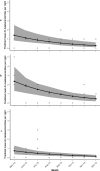
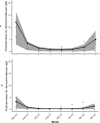
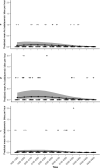
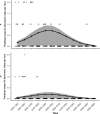
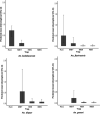
Similar articles
-
Evaluation of electric nets as means to sample mosquito vectors host-seeking on humans and primates.Parasit Vectors. 2017 Jul 18;10(1):338. doi: 10.1186/s13071-017-2277-3. Parasit Vectors. 2017. PMID: 28720113 Free PMC article.
-
Effect of different habitat types on abundance and biting times of Anopheles balabacensis Baisas (Diptera: Culicidae) in Kudat district of Sabah, Malaysia.Parasit Vectors. 2019 Jul 25;12(1):364. doi: 10.1186/s13071-019-3627-0. Parasit Vectors. 2019. PMID: 31345256 Free PMC article.
-
Human exposure to zoonotic malaria vectors in village, farm and forest habitats in Sabah, Malaysian Borneo.PLoS Negl Trop Dis. 2020 Sep 4;14(9):e0008617. doi: 10.1371/journal.pntd.0008617. eCollection 2020 Sep. PLoS Negl Trop Dis. 2020. PMID: 32886679 Free PMC article.
-
Current status of Plasmodium knowlesi vectors: a public health concern?Parasitology. 2018 Jan;145(1):32-40. doi: 10.1017/S0031182016000901. Epub 2016 May 25. Parasitology. 2018. PMID: 27222102 Review.
-
Zoonotic malaria transmission and land use change in Southeast Asia: what is known about the vectors.Malar J. 2022 Mar 31;21(1):109. doi: 10.1186/s12936-022-04129-2. Malar J. 2022. PMID: 35361218 Free PMC article. Review.
Cited by
-
Impact of environmental factors on the bionomics of Anopheles mosquito vectors of zoonotic malaria: A narrative review.One Health. 2025 Jul 14;21:101141. doi: 10.1016/j.onehlt.2025.101141. eCollection 2025 Dec. One Health. 2025. PMID: 40727445 Free PMC article. Review.
-
Plasmodium knowlesi (Pk) Malaria: A Review & Proposal of Therapeutically Rational Exchange (T-REX) of Pk-Resistant Red Blood Cells.Trop Med Infect Dis. 2023 Oct 20;8(10):478. doi: 10.3390/tropicalmed8100478. Trop Med Infect Dis. 2023. PMID: 37888606 Free PMC article. Review.
-
Lords of the flies: dipteran migrants are diverse, abundant and ecologically important.Biol Rev Camb Philos Soc. 2025 Aug;100(4):1635-1659. doi: 10.1111/brv.70017. Epub 2025 Apr 1. Biol Rev Camb Philos Soc. 2025. PMID: 40165599 Free PMC article. Review.
-
Plasmodium knowlesi Infection in Traveler Returning to Canada from the Philippines, 2023.Emerg Infect Dis. 2023 Oct;29(10):2177-2179. doi: 10.3201/eid2910.230809. Emerg Infect Dis. 2023. PMID: 37735805 Free PMC article. Review.
-
Prevalence of culicine salivary antibodies in non-human primates living in national parks in Thailand.Med Vet Entomol. 2025 Jun;39(2):278-290. doi: 10.1111/mve.12779. Epub 2024 Nov 25. Med Vet Entomol. 2025. PMID: 39585182 Free PMC article.
References
-
- Organization WH . World malaria report 2020: 20 years of global progress and challenges. Geneva: Organization WH; 2020.
-
- Philippines DoH-Rot. Shell, DOH aim to wipe out malaria in PH by 2030; 2020. https://doh.gov.ph/press-release/Phl-Malaria-Free-by-2030-DOH.
-
- D N. Only 4 provinces have cases of malaria. https://mb.com.ph/2020/02/15/only-4-ph-provinces-have-cases-of-malaria/. Accessed 13 Jan 2021.
MeSH terms
Grants and funding
LinkOut - more resources
Full Text Sources
Medical

